School Safety Rules
Category : Blog
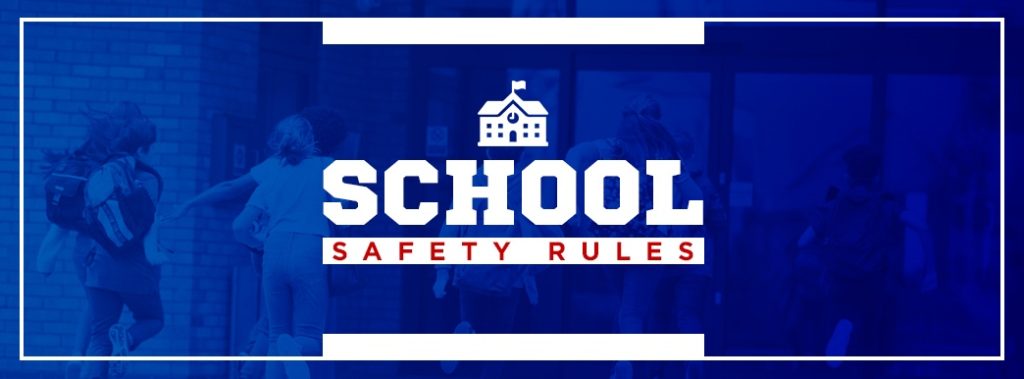
For many students, staff and faculty around the country, going to school is just part of their daily routine. Navigating through the hallways and going from class to class has become second nature, so many students don’t even think about it. School should be a place for students to learn, grow and make new friends. Therefore, feeling safe is the last thing students, staff and faculty should have to worry about as they work through the school year. However, recent events have shifted students’ sense of security, which is why it’s crucial to discuss the importance of school and classroom safety.
School and Classroom Safety: Why It’s Important
As defined by the National Center on Safe Supportive Learning Environments, school safety refers to schools as well as school-related activities where students are safe from bullying, harassment, violence and substance abuse. School and classroom safety has been proven to link to positive outcomes for the school and students. If students feel safe in their school, they are more likely to be high achievers academically.
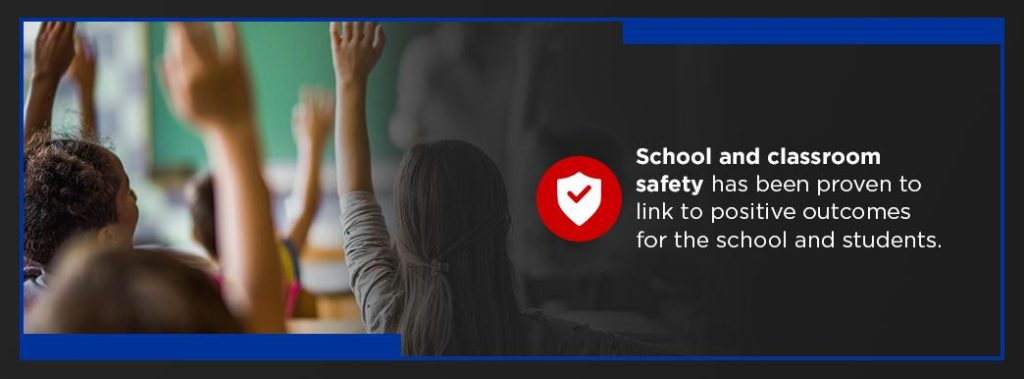
More specifically, feeling physically safe in school is also related to fewer risky behaviors and lower dropout rates. If students can feel at ease in school, they can focus on their work and feel more connected to their school without having to worry about their safety. On the flip side, in schools with higher levels of “collective hostility” — measured by student reports of feeling unsafe, gang presence and frequency of fighting between different student groups — student achievement is more likely to suffer.
What’s the consensus when it comes to students’ thoughts on feeling safe in school? According to a survey that asked 35,000 fifth-through-twelfth graders across eight different states if they feel safe in the classroom, about two-thirds said yes. While this is certainly a majority of students who feel safe inside the classroom, how do they feel as they go outside or travel the hallways?
When it comes to the school outside of the classroom, only 59% said they felt safe at school in general while 55% of students said they felt safe outside the school building, still on school property. Meanwhile, only 54% said they felt safe in the hallways, bathrooms and locker rooms.
Some students also feel that there is a disconnect between their worries and the concerns of the school’s staff and faculty. According to Safe and Sound Schools, students reported feeling like their school was in denial about the possibility of danger. Additionally, more than half of the students surveyed believe their school lacks awareness regarding school safety issues. The students also think their schools falsely believe that events taking place around the country could never happen at their school.
With school shootings becoming more frequent occurrences, it’s understandable why students and even parents are hesitant when it comes to school safety. By October 2019, Education Week reported that there had been 17 school shootings with injuries or deaths that year alone. In a world where kids are feeling scared just to get an education, it’s time to have conversations with students, staff and faculty to stress the importance of school safety. One way to help increase efforts of school safety is to establish and enforce school rules that everyone can follow.
Safety Rules in the School
With more than 76 million students currently enrolled in schools across the U.S., it’s essential to have specific rules and protocols to keep things safe. Since school is ultimately the place for students to learn and interact with others, school safety rules can help keep things orderly and secure so students can continue a worry-free education.
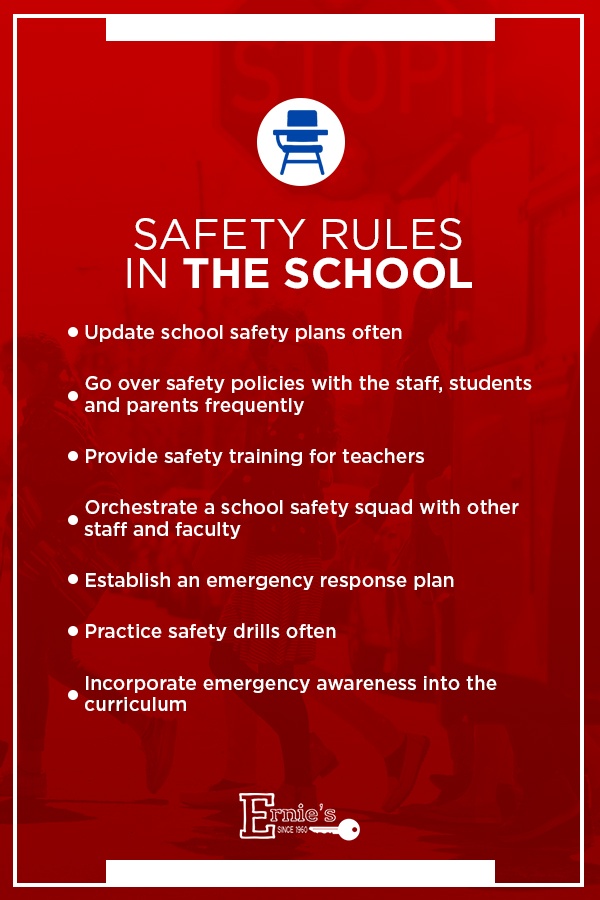
- Update school safety plans often. A school safety plan that was created for your school last year runs the risk of being outdated. It’s crucial to get in the habit of reviewing safety plans often and updating them as necessary. Since each school year is different, you should incorporate problems that arise during the school year into the next year’s safety plan, if not sooner. Your school should also think about which concerns it finds the most important to the community, so the school may focus its efforts on those specific concerns.
- Go over safety policies with the staff, students and parents frequently. A school’s staff must have a clear understanding of all safety policies so they can appropriately enforce the policies with their students. For teachers to be the best they can be, they must be all on the same page. Classroom safety rules should be readily available and distributed throughout the school to each room. Teachers should also make sure their students are taking home these safety policies so parents can also stay up to date with any vital information. Some schools come up with different ways to share policies — such as using pictures or videos — to move away from the repetitive method of distributing a traditional printed out list of classroom safety rules.
- Provide safety training for teachers. As a teacher, you are responsible for the 20 to 30 students in your classroom at any given time. With training opportunities, you can feel more prepared to protect. There are a few different options for training your school may offer. Some courses teach staff how to keep behaviors under control and address a situation before it gets out of hand. Others focus on how to see the different warning signs of crisis to take action fast. Some programs are for students and staff, covering numerous problems from bullying to fire extinguisher safety, while others help prepare staff for an active shooter situation.
- Orchestrate a school safety squad with other staff and faculty. If safety is high on your school’s list of priorities, you may decide you need a safety committee! With other staff and faculty in your school, you can team up and volunteer to delve even deeper into safety measures. By assigning different members of the committee individual roles, such as an emergency planner or communication coordinator, people can feel like they’re making a difference. Roles also help hold people accountable while making problem management significantly easier.
- Establish an emergency response plan. In any emergency, your school must know how to respond appropriately. By creating a clearly outlined emergency response plan with four key components — prevent, prepare, respond and recover — you’re on the right track. For prevention, it’s important to develop school safety rules and resources, such as anti-violence or anti-bullying policies to try and keep problems at bay. But problems are inevitable, which is why you must also have a plan for responding to an emergency. Have a crisis communication strategy to inform parents and the public about what happened. Emergencies don’t end there, so it’s essential you also have a recovery plan to start putting the pieces back together and move forward.
- Practice safety drills often. Even if your school has regularly scheduled safety drills once a month, it’s important to continue practicing them with your students in the classroom. From weather drills to lockdown drills, students must prepare for any situation and know what to do.
- Incorporate emergency awareness into the curriculum. Depending on how serious your school is about emergency preparedness and the flexibility of the curriculum, you may be able to include emergency awareness into lessons in the classroom. FEMA’s Youth Emergency Preparedness Curriculum-Ready Kits allow students in grades one through 12 to learn more about responding to an emergency while still practicing everyday skills. Ready Kids is another place kids, teens, families and educators and organizations can go to learn more about emergency preparedness through numerous resources.
How to Keep Your School and Classroom Safe
Considering the importance of school safety, the different ways to secure your school and classroom continue to grow. To keep your school and classroom safe, consider these tips for added peace of mind.
1. Only Allow People Entry From One Specific Place
One clear, designated entry point makes it easier to keep track of everyone coming in and out. To determine if your school is using the safest entrance possible, your school may want to perform a safety audit. A safety audit looks at things such as how your school is locking doors and how visitors enter the school. It can also find any line of sight issues and determine how people move throughout the building. With one entry point, many schools also put up some form of intercom call box at the entrance to communicate visitors and see why they need to enter the building.
2. Enforce a Tight Visitor Policy
Since parents trust schools to keep their children safe, all schools must maintain a strict policy on visitors coming in and out of the building. Front office staff should require all visitors to go through a check-in process. Visitors must show ID, provide a phone number, write the date and time of arrival and explain why they’re visiting the school. To distinguish staff and faculty from visitors, staff and faculty should be required to wear a photo ID badge.
3. Introduce Visitor Management Software
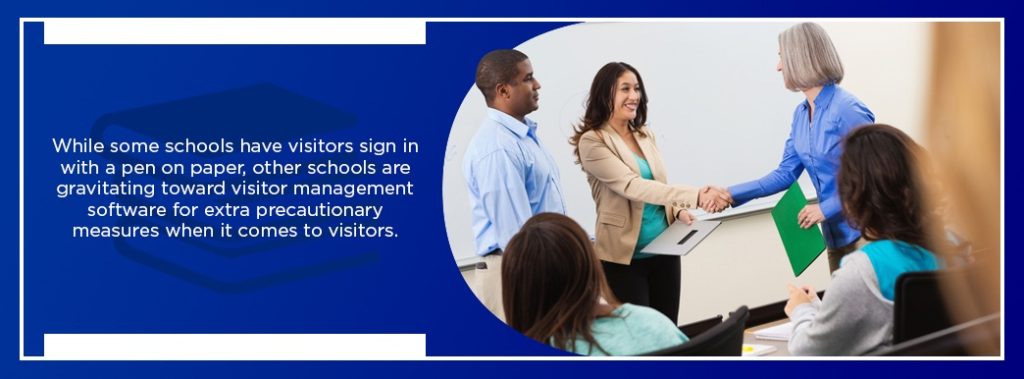
While some schools have visitors sign in with a pen on paper, other schools are gravitating toward visitor management software for extra precautionary measures when it comes to visitors. Since log-in sheets may not always get filled out or could easily become lost, having software to check visitors in is both easier and more reliable. Visitor management software can also run all state-issued IDs through a database, which helps schools learn about who is coming through their door. Visitor management software may also be able to run background checks for that extra layer of security. When the data the visitor management software collects is put into cloud storage, you can keep better track of who is visiting your school at any time.
4. Keep Front Doors Locked
Once the day starts, your school’s front entrance should be locked up and secure. While students enter school at the beginning of the day and leave school at the end of the day, school staff or faculty should watch the entrances and exits and control flow of who’s coming in and who’s going out. It would also be a good idea to ensure all classrooms have working locks. In the case of a lockdown drill or real-life crisis, it’s essential to ensure no one can gain access to your room. It’s crucial to teach your students that they shouldn’t open the door for anyone until they know who’s knocking. For security’s sake, school entrances should have two sets of locked doors that can be easily seen on security footage.
5. Make Sure Technology Is Up to Date
In addition to the front entrance, security cameras may be set up elsewhere around the school. But with technology, you must make sure it’s updated. What good is a security camera if the quality is so bad you can’t even make out the footage? Technology also refers to classroom telephones, walkie-talkies and intercoms throughout the building. In an emergency where you need to communicate with other faculty and staff, these tools must be in good working order. As technology progresses, your school can look into new and improved methods of security. Examples include video surveillance that also takes pictures of people coming into the building or emergency buttons that immediately notify 911 when pushed.
Increase Safety at Your School With Ernie’s Locksmith and Key Services
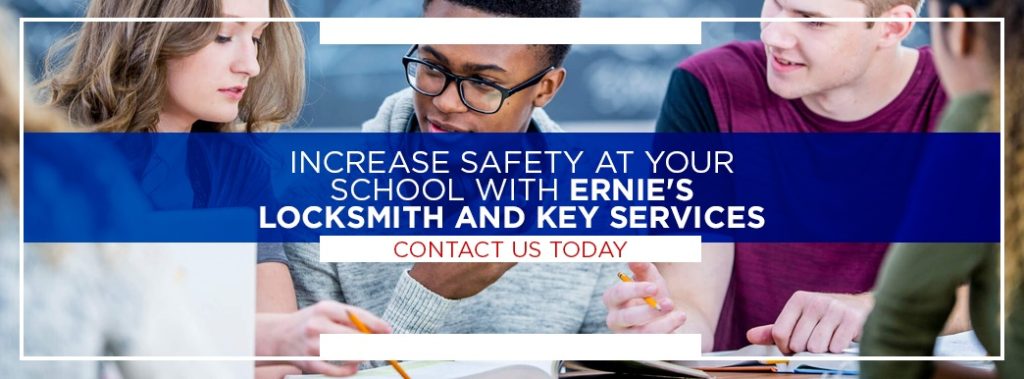
To ensure everyone can continue to keep school a safe place, we must have conversations about the importance of school safety. This includes going over school and classroom safety rules and identifying other ways everyone can feel secure in the building. Whether you’re looking for custom master key systems or to install keyless and electronic access systems, Ernie’s Lock Company can provide quality commercial locksmith and security services to schools in Riverdale, MD and surrounding areas. We understand that there’s no better investment than an investment in security, so contact Ernie’s Lock Company today for your commercial locksmith needs.
